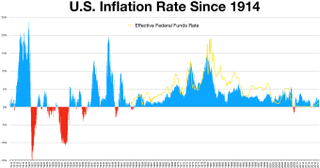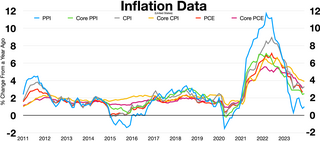
In economics, inflation refers to a general progressive increase in prices of goods and services in an economy. When the general price level rises, each unit of currency buys fewer goods and services; consequently, inflation corresponds to a reduction in the purchasing power of money. The opposite of inflation is deflation, a sustained decrease in the general price level of goods and services. The common measure of inflation is the inflation rate, the annualised percentage change in a general price index.
An economic indicator is a statistic about an economic activity. Economic indicators allow analysis of economic performance and predictions of future performance. One application of economic indicators is the study of business cycles. Economic indicators include various indices, earnings reports, and economic summaries: for example, the unemployment rate, quits rate, housing starts, consumer price index, Inverted yield curve, consumer leverage ratio, industrial production, bankruptcies, gross domestic product, broadband internet penetration, retail sales, price index, and money supply changes.

A consumer price index (CPI) is a price index, the price of a weighted average market basket of consumer goods and services purchased by households. Changes in measured CPI track changes in prices over time.
In economics, the GDP deflator is a measure of the level of prices of all new, domestically produced, final goods and services in an economy in a year. GDP stands for gross domestic product, the total monetary value of all final goods and services produced within the territory of a country over a particular period of time.
Price stability is a goal of monetary and fiscal policy aiming to support sustainable rates of economic activity. Policy is set to maintain a very low rate of inflation or deflation. For example, the European Central Bank (ECB) describes price stability as a year-on-year increase in the Harmonised Index of Consumer Prices (HICP) for the Euro area of below 2%. However, by referring to "an increase in the HICP of below 2%" the ECB makes clear that not only persistent inflation above 2% but also deflation are inconsistent with the goal of price stability.
A cost-of-living index is a theoretical price index that measures relative cost of living over time or regions. It is an index that measures differences in the price of goods and services, and allows for substitutions with other items as prices vary.
The PCE price index (PCEPI), also referred to as the PCE deflator, PCE price deflator, or the Implicit Price Deflator for Personal Consumption Expenditures by the BEA, and as the Chain-type Price Index for Personal Consumption Expenditures (CTPIPCE) by the Federal Open Market Committee (FOMC), is a United States-wide indicator of the average increase in prices for all domestic personal consumption. It is benchmarked to a base of 2012 = 100. Using a variety of data including U.S. Consumer Price Index and Producer Price Index prices, it is derived from the largest component of the GDP in the BEA's National Income and Product Accounts, personal consumption expenditures.

The Producer Price Index (PPI) is the official measure of producer prices in the economy of the United States. It measures average changes in prices received by domestic producers for their output. The PPI was known as the Wholesale Price Index, or WPI, up to 1978. It is published by the Bureau of Labor Statistics and is one of the oldest economic time series compiled by the Federal government of the United States.
In the United Kingdom, the Retail Prices Index or Retail Price Index (RPI) is a measure of inflation published monthly by the Office for National Statistics. It measures the change in the cost of a representative sample of retail goods and services.
The Harmonised Index of Consumer Prices (HICP) is an indicator of inflation and price stability for the European Central Bank (ECB). It is a consumer price index which is compiled according to a methodology that has been harmonised across EU countries. The euro area HICP is a weighted average of price indices of member states who have adopted the euro. The primary goal of the ECB is to maintain price stability, defined as keeping the year on year increase HICP below but close to 2% for the medium term. In order to do that, the ECB can control the short-term interest rate through Eonia, the European overnight index average, which affects market expectations. The HICP is also used to assess the convergence criteria on inflation which countries must fulfill in order to adopt the euro. In the United Kingdom, the HICP is called the CPI and is used to set the inflation target of the Bank of England.

The employment cost index (ECI) is a quarterly economic series detailing the changes in the costs of labor for businesses in the United States economy. The ECI is prepared by the Bureau of Labor Statistics (BLS), in the U.S. Department of Labor.

The United States Consumer Price Index (CPI) is a set of consumer price indices calculated by the U.S. Bureau of Labor Statistics (BLS). To be precise, the BLS routinely computes many different CPIs that are used for different purposes. Each is a time series measure of the price of consumer goods and services. The BLS publishes the CPI monthly.
Headline inflation is a measure of the total inflation within an economy, including commodities such as food and energy prices, which tend to be much more volatile and prone to inflationary spikes. On the other hand, "core inflation" is calculated from a consumer price index minus the volatile food and energy components. Headline inflation may not present an accurate picture of an economy's inflationary trend since sector-specific inflationary spikes are unlikely to persist.
This page lists details of the consumer price index by country

James Brian Bullard is the chief executive officer and 12th president of the Federal Reserve Bank of St. Louis, positions he has held since 2008. He is currently serving a term that began on March 1, 2021. In 2014, he was named the 7th most influential economist in the world in terms of media influence.
The consumer price index (CPI) is the official measure of inflation in South Africa. One variant, the consumer price index excluding mortgage costs (CPIX), is officially targeted by the South African Reserve Bank and a primary measure that determines national interest rates.

Constant purchasing power accounting (CPPA) is an accounting model that is an alternative to traditional historical cost accounting under high inflation and hyper-inflationary environments. It has been approved for use by the International Accounting Standards Board (IASB) and the US Financial Accounting Standards Board (FASB). Under this IFRS and US GAAP authorized system, financial capital maintenance is always measured in units of constant purchasing power (CPP) in terms of a Daily CPI during low inflation, high inflation, hyperinflation and deflation; i.e., during all possible economic environments. During all economic environments it can also be measured in a monetized daily indexed unit of account or in terms of a daily relatively stable foreign currency parallel rate, particularly during hyperinflation when a government refuses to publish CPI data.
Monetary policy is the monitoring and control of money supply by a central bank, such as the Federal Reserve Board in the United States of America, and the Bangko Sentral ng Pilipinas in the Philippines. This is used by the government to be able to control inflation, and stabilize currency. Monetary Policy is considered to be one of the two ways that the government can influence the economy – the other one being Fiscal Policy. Monetary Policy is generally the process by which the central bank, or government controls the supply and availability of money, the cost of money, and the rate of interest.
Inflation rate in India was 5.5% as of May 2019, as per the Indian Ministry of Statistics and Programme Implementation. This represents a modest reduction from the previous annual figure of 9.6% for June 2011. Inflation rates in India are usually quoted as changes in the Wholesale Price Index (WPI), for all commodities.
The United States Chained Consumer Price Index (C-CPI-U), also known as chain-weighted CPI or chain-linked CPI is a time series measure of price levels of consumer goods and services created by the Bureau of Labor Statistics as an alternative to the US Consumer Price Index. It is based on the idea that when prices of different goods change at different rates, consumers will adjust their purchasing patterns by purchasing more of products whose relative prices have declined and fewer of those whose relative price has increased. This reduces the cost of living reported, but has no change on the cost of living; it is simply a way of accounting for a microeconomic "substitution effect." The "fixed weight" CPI also takes such substitutions into account, but does so through a periodic adjustment of the "basket of goods" that it represents, rather than through a continuous adjustment in that basket. Application of the chained CPI to federal benefits has been controversially proposed to reduce the federal deficit.







